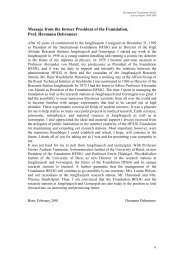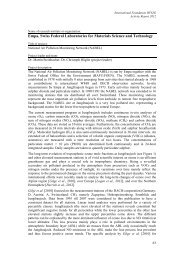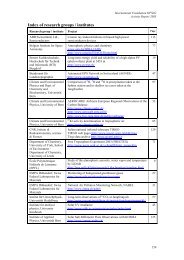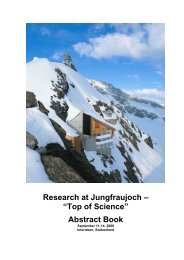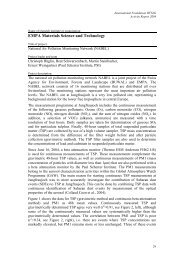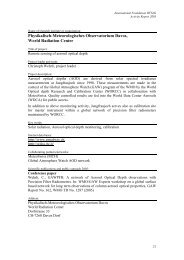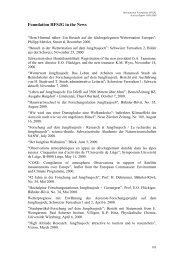Activity Report 2005 - International Foundation High Altitude ...
Activity Report 2005 - International Foundation High Altitude ...
Activity Report 2005 - International Foundation High Altitude ...
You also want an ePaper? Increase the reach of your titles
YUMPU automatically turns print PDFs into web optimized ePapers that Google loves.
<strong>International</strong> <strong>Foundation</strong> HFSJG<br />
<strong>Activity</strong> <strong>Report</strong> <strong>2005</strong><br />
Starting in spring <strong>2005</strong>, the buildings at Gornergrat that are the property of the<br />
Burgergemeinde Zermatt and the Gornergrat Bahn underwent a complete refurbishing<br />
to make the entire site more attractive for tourists and as well as for science. The<br />
extended renovation work necessitated closing the Kulm Hotel and both observatories<br />
from April through December. Upon the announcement of the renovation and the<br />
ensuing interruption of all operations, INAF decided that this was an appropriate time<br />
to conclude the present contract for Gornergrat North (which was due to expire in<br />
<strong>2005</strong> anyway) and to completely dismantle TIRGO. This leaves the future of<br />
Gornergrat North open, but discussions are ongoing, although no final solutions have<br />
been found. The Burgergemeinde would like for us to use Gornergrat North to embed<br />
science in public outreach and tourism. Since January 1, 2006, there has been no one<br />
at the Observatory Gornergrat North.<br />
The <strong>High</strong> <strong>Altitude</strong> Research Station Jungfraujoch will celebrate its 75th anniversary<br />
in the summer of 2006. From its beginnings as an astronomical observatory and a<br />
station where acute mountain sicknesses were studied, the Scientific Station<br />
Jungfraujoch has evolved during its 75 year history into one of the most renowned<br />
centers in Europe for environmental sciences. To celebrate this important event<br />
several special projects are planned. One of them is an international scientific<br />
conference to be held from September 11-14, 2006, at the Casino-Kursaal in<br />
Interlaken. A scientific committee, headed by Prof. Heinz Hugo Loosli and the<br />
director HFSJG, is in the process of organizing the conference. An extraordinary<br />
meeting of the board HFSJG is scheduled for September 14, 2006.<br />
The <strong>High</strong> <strong>Altitude</strong> Research Station Jungfraujoch<br />
As documented by the individual reports and the lists and statistics, the <strong>High</strong> <strong>Altitude</strong><br />
Research Station Jungfraujoch continued to be a place of exceptionally lively and<br />
exciting research. In <strong>2005</strong>, 36 teams were active at Jungfraujoch. Among a total of 41<br />
research projects, 20 were primarily based on automatic measurements around the<br />
clock. In February, in response to a proposal by Mr. Daniel Keuerleber, director of<br />
MeteoSchweiz, the research station Jungfraujoch was named the 23 rd global GAW<br />
(Global Atmosphere Watch) station by the World Meteorological Organisation<br />
(WMO). Please see the WMO announcement on page 221.<br />
All member countries of the <strong>Foundation</strong> benefited from the excellent research<br />
conditions (Figure 1). By number of projects, Germany was again the second largest<br />
user after Switzerland. Scientists spent a total of 1432 person-working days at<br />
Jungfraujoch. As shown in Figure 2, this number is well above the long-term average.<br />
Figure 3 illustrates the relative number of person-working days for <strong>2005</strong> by country.<br />
Leading in presence at Jungfraujoch were the Institut d’Astrophysique et<br />
Géophysique de l’Université de Liège (350 person-working days), the Institute for<br />
Human Movement Sciences, Swiss Federal Institute of Technology Zurich (ETHZ),<br />
and Institute of Physiology, University of Zurich (247), the Paul Scherrer Institut<br />
(123), and the School of Earth, Atmospheric and Environmental Sciences, University<br />
of Manchester (101). Participants of the Cloud Aerosol Characterisation Experiment<br />
4 (CLACE 4) spent more than 540 days at the research station. Complementing the<br />
automatic meteorological measurements, our custodians continued the daily weather<br />
observations for the Federal Office of Meteorology and Climatology (MeteoSwiss).<br />
The custodians also provide the updates for the internet weather report of the<br />
Jungfraubahnen.<br />
iv



